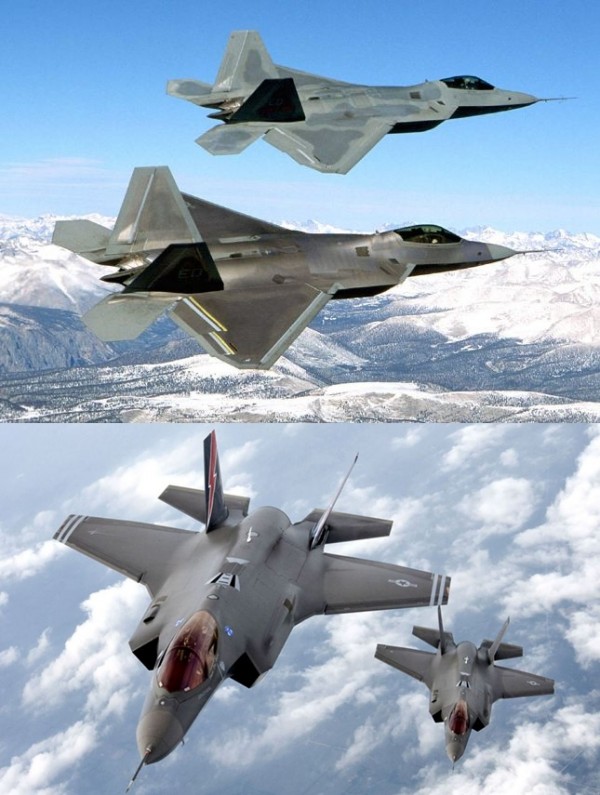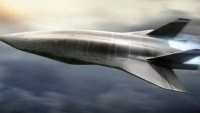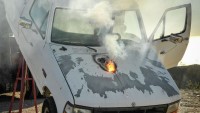Report Reveals Plans for US Air Force F-22s and F-35s in War against China
| Arthur Dominic Villasanta | | Jul 01, 2016 03:30 AM EDT |
(Photo : USAF/USN) F-22s in flight (top) and F-35s
The U.S. Air Force will rely heavily on its fifth generation stealth fighters, the F-22 Raptor and the F-35 Joint Strike Fighter, in an all-out war against China in Asia and a report by ranking Air Force officers has revealed how it plans to do so for the first time.
Maj. Gen. Jeffrey Harrigian, Director, F-35 Integration Office, Headquarters U.S. Air Force at the Pentagon and Col. Max Marosko III, Deputy Director for Air and Cyberspace Operations at Joint Base Pearl Harbor-Hickam in Hawaii, laid out a scenario in which a war with China ignites in 2026 in a recently published report.
Like Us on Facebook
China isn't named directly but there's no mistaking the adversary is China based on the details presented, and the fact China is the United States' only major strategic competitor located solely in Asia.
In this fictitious war, the Air Force will disperse its F-22s, F-35s, B-2 Spirit stealth bombers and B-21 "China bombers" currently under development in small numbers to military and civilian airfields at Pacific Ocean bases. This to prevent Chinese ballistic and cruise missiles from delivering a devastating knock-out blow to one big base in the event of a Pearl Harbor-type sneak attack.
Some of these air bases might be as far away as 1,000 miles from the battlefield. The Pentagon plans to concentrate most of its planes at what it calls "regional super bases."
Gen. Harrigian and Col. Marosko noted F-22s and F-35 will fly missions more frequently than fourth generation jets such as the F-16 and F-15.
"If you put a fourth-(generation F-15 or F-16 fighter) in there, they're gonna die," said Gen. Harrigian.
He was referring to advanced Chinese radars capable of easily detecting and tracking the un-stealthy F-16 and F-15 at very long range, and advanced surface-to-air missiles (SAMs) with slant ranges in excess of 200 kilometers.
And unlike fourth gen jets, F-22s and F-35s will receive targeting information from command centers through high-tech computers and communications equipment as they hurtle towards the battlefield. There must also be connectivity improvements between fourth generation and fifth generation fighters to ensure mission success.
The Air Force will have to deploy its F-22s and F-35s more quickly from bases in the United States since China can move its forces around the battlefield, said Col. Marosko. Deployments of these fighters must be accomplished with fewer equipment and fewer people.
The Air Force's stealth fighters also need to collect and upload data to command centers and other aircraft more quickly. Gen. Harrigian said data must be pushed into the cloud much faster for it to be timely.
"There's going to be a huge reliance on all that data ... getting back to the mother ship," said Col. Marisko.
Gen. Harrigian and Col. Marosko also said that during the initial days of the war against China, F-35s will have to divert to civilian airfields should they find their air bases damaged by Chinese attacks. This dispersion won't hinder combat operations since F-22s and F-35s won't need air traffic controllers since their sophisticated computers will guide them to runways even in bad weather.
"In our minds, what this comes down to is the ability to kill and survive," said Gen. Harrigian.
TagsU.S. Air Force, F-22 Raptor, F-35 Joint Strike Fighter, china, Maj. Gen. Jeffrey Harrigian, Col. Max Marosko III
©2015 Chinatopix All rights reserved. Do not reproduce without permission
EDITOR'S PICKS
-

Did the Trump administration just announce plans for a trade war with ‘hostile’ China and Russia?
-

US Senate passes Taiwan travel bill slammed by China
-

As Yan Sihong’s family grieves, here are other Chinese students who went missing abroad. Some have never been found
-

Beijing blasts Western critics who ‘smear China’ with the term sharp power
-

China Envoy Seeks to Defuse Tensions With U.S. as a Trade War Brews
-

Singapore's Deputy PM Provides Bitcoin Vote of Confidence Amid China's Blanket Bans
-

China warns investors over risks in overseas virtual currency trading
-

Chinese government most trustworthy: survey
-

Kashima Antlers On Course For Back-To-Back Titles
MOST POPULAR
LATEST NEWS
Zhou Yongkang: China's Former Security Chief Sentenced to Life in Prison

China's former Chief of the Ministry of Public Security, Zhou Yongkang, has been given a life sentence after he was found guilty of abusing his office, bribery and deliberately ... Full Article
TRENDING STORY

China Pork Prices Expected to Stabilize As The Supplies Recover

Elephone P9000 Smartphone is now on Sale on Amazon India

There's a Big Chance Cliffhangers Won't Still Be Resolved When Grey's Anatomy Season 13 Returns

Supreme Court Ruled on Samsung vs Apple Dispute for Patent Infringement

Microsoft Surface Pro 5 Rumors and Release Date: What is the Latest?













